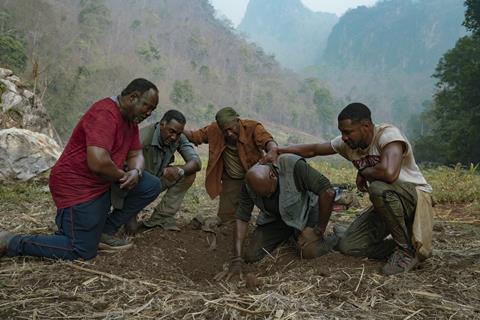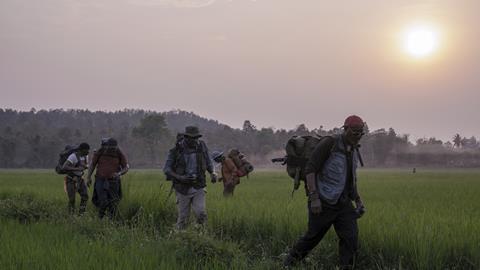With racial tensions heightening in the US, IBC365 goes behind the scenes of Spike Lee’s return to Vietnam, which sets the record straight on the white-washed reporting of the war and draws explicit parallels with the rise of fascism today.

Spike Lee’s Da 5 Bloods is a raised fist of defiance. The opening montage of newsreel footage explicitly links the oppression of poor non-white people by the U.S army in Vietnam and Cambodia with the violent suppression of anti-war and civil rights movements happening contemporaneously back home.
There’s no grey in Lee’s black and white message. “If the link is not made between what is happening in Vietnam and what is happening here we may well face a period of full blown fascism,” activist Angela Davis said in 1969, quoted in the film.
“America has declared war on black people,” is activist Kwame Ture’s stark statement from 1970, also framed and featured.
Just like his previous film, (Oscar-winning) BlackKklansman, which also detailed how little America has changed since the ’70s, Lee’s drama is startlingly prescient. He might argue that the story required no foresight: the slavery on which the United States is built has never gone away.
It’s a point made in the film by Stormin’ Norman, played by Chadwick Boseman, the inspirational leader of a group of black soldiers who is described by his comrades as being “our Malcolm, our Martin.”
In the film, this group reunites in Ho Chi Minh decades on from their tours of duty on a mission to rekindle old friendships and recover a stash of gold bullion. The light hearted tourism at the outset of the story shifts into darker territory once they re-enter the jungle.
“On the one hand this was Spike’s take on The Treasure of the Sierra Madre [John Huston’s 1948 tale of greed and gold] but he clearly saw the premise, about the role of African American soldiers in Vietnam, as a canvas to represent a much bigger story about America today,” says cinematographer Newton Thomas Sigel ASC (X-Men, The Usual Suspects, Drive).
“They were put into a third world county where they in some way identified more with the plight of the local people than their white comrades in arms.” - Siegel
Sigel first met the director in New York in the early 1980s while both were making documentaries and had shot a number of commercials together since but this is their first feature collaboration.
“Spike has a very distinctive storytelling style that he has developed over many years and which always finds its way into his films,” Sigel says. “Whether that’s characters talking direct to camera or the choreography of a scene there are a lot of consistent threads that run through his work that I knew would be part of his vocabulary in this film.”
Lee tropes in Da 5 Bloods also include split-screens, archival photos, and pointed political commentary.
The main character wears a Make America Great Again cap as ironic talisman; footage of a Trump rally from 2016 is called out for its token [uncle] ‘Tom’ black cheerleader; it ends with a BlackLivesMatter chant.

Lee also directed Sigel to frame the four lead actors as a collective to emphasise their loyalty and equality to one another.
“Spike was very keen to show all the guy’s interactions happening at once in a wide shot. Even if we changed angle it would be cut to another group shot rather than the usual close up or single shot. What that did in turn was that when we do move to close up these are more are powerful than usual.”
An example is a lengthy monologue on the face of actor Delroy Lindo speaking direct to camera. His character suffers from post-traumatic stress disorder and embodies the anguish at the heart of Lee’s story.
“We wanted to show the sort of dislocation that black soldiers in Vietnam had from the war as a whole in the sense that they were a disenfranchised part of the American population being asked to fight on behalf of a system that had denied them equal rights and justice,” Sigel says. “They were put into a third world county where they in some way identified more with the plight of the local people than their white comrades in arms.”
Sigel says the documentaries Hearts and Minds (1975), Ken Burns’ The Vietnam War and iconic feature Apocalypse Now, were all tonal influences. Coppola’s film is referenced at least three times in Da 5 Bloods including the film’s poster as backdrop to a nightclub, Wagner’s Ride of the Valkyries theme playing out over a river boat ride and a shot of a helicopter in silhouette against the sun.
“That shot recalls the opening to Apocalypse Now,” Sigel confirms. “Mostly, though, we wanted the kind of surreal feeling of being there in Vietnam and which Apocalypse Now expressed very strongly as a kind of psychedelic experience. Some of that epic altered state quality found itself way into 5 Bloods.”
Lee had committed to shooting the bulk of production in Thailand with additional scenes on location in Vietnam.
“He was adamant about the verisimilitude of shooting in Ho Chi Minh City and felt the same with casting. It wouldn’t be right, he felt, not to have Vietnamese actors presenting themselves and with very few exceptions all the Vietnamese characters and extras are locally cast.”

Sigel shot the film on the ARRI Alexa LF using ARRI’s DNA lens package and contrasted the epic format of the digital camera with flashback scenes shot on 16mm.
“I used 16mm reversal stock which we developed as reversal which was basically the it way would have been done by a news crews at the time.”
Reversal film avoids the expense of using negative stock, which requires additional time and expense to process to create a positive film print for projection.
“I began my career shooting docs and news on 16mm and would have covered Vietnam if I had been just a little bit older,” Sigel says, who has filmed from Central American war zones in the 1980s.
The flashback ‘memory’ sequences are filmed in 4:3 aspect ratio in part to match the format of the archive footage used at points throughout the film. This contrasts with modern Ho Chi Minh sequences framed at 2.39:1 which is subtly changed to 1.85:1 when the story hits the jungle.
“The interesting thing is that when the 1.85:1 format is shown on Netflix the top and bottom of the frame actually open up showing more of the canopy and expressing the cocoon like endless quality of the jungle.”
Also in the mix is Super 8 footage mostly filmed by actor Norm Lewis whose character carries a Super 8 camcorder.
Jungle greens dominate the film’s colour palette, with the exception of blood red. “Red was a sort of symbol of [the group’s] strength and purpose and of the passionate intensity of the quest,” Sigel says. “Part of its power and value is that you can use it as complement to green so when you hit the jungle the green takes on an even stronger vibrancy. I tried as much as a could to play with that.”
Lee’s script (written with Danny Bilson, Paul de Meo and Kevin Willmott) also takes aim at Rambo, quotes the “madness” from anti-war classic The Bridge on the River Kwai, and leans on Black Hawk Down as inspiration for a helicopter crash scene.
“We wanted to shoot as much in camera as we could and tried to avoid CG helis,” Sigel explains. “For that scene we shot the actors in a non-working shell of a helicopter being rocked on a gimbal, combined with some air to air material down to the crash and the crash itself is CG. The rest is practical.”
This was Sigel’s second picture back to back in Thailand and third film he has shot in the country overall. He was in two minds about agreeing to Lee’s picture because of the compressed schedule between finishing Extraction, the Liam Hemsworth actioner also for Netflix, and starting Da 5 Bloods.
“Extraction was a massive production and I wondered how I was ever going to have time to prep and do Spike justice and not let him down. But having shot in Thailand I think that gave me an advantage. I knew what I was getting into.”
Sigel was also a second unit camera on Oliver Stone’s Best Picture winner Platoon which was shot by Robert Richardson ASC. The memorable image of Sergeant Elias (Willem Dafoe) chased from the jungle and dying, Christ-like, hands in the air, is acknowledged by Richardson to be Sigel’s.
“I’m proud of my work on that movie and I was lucky enough to be on the ground that day while he was filming in a different place,” Sigel says. “Bob and I have become life-long friends and it shows how generous he is that gives credits for that moment. That was my shot in a Bob Richardson film.”
Sigel adds that his own first love is with visual storytelling. “I’m a visually oriented person. It’s instinctual. I shoot before I really understand what has attracted me to the image. I never set out to make movies but storytelling through a lens has always fascinated me and took me down this path of cinematography.”




























No comments yet